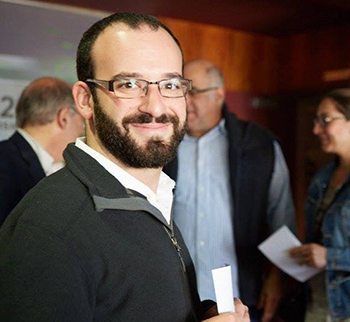
Michael Rettig
For a century, Michael Rettig’s family has passed down boxes upon boxes of photographs, papers, records and other documents. But because most of it was written in Armenian, no one knew much about what it all meant.
When his grandmother invited him to take a look, Rettig became eager to investigate, to fill in the gaps in both scholarly research and his family's own knowledge about their fascinating history.
Rettig is a great-great-grandson of Thomas Muggerditchian, a British Pro-Consul who served in Turkey in the beginning of the 20th century and wrote one of the earliest reports of the 1915 genocide in Armenia, first published in 1919 and titled The Diyarbekir Massacres and Kurdish Atrocities.
Rettig, a master’s student in history at Fresno State University, has made it his mission to research and archive his family’s artifacts as he works on a master’s thesis about the Armenian British consuls like Thomas who served as liaisons between Europe and the Middle East around the turn of the 20th century.
People all over the world can get a personal glimpse into Muggerditchian’s life through the testimony of his daughter, Alice Muggerditchian Shipley, which is integrated into the Visual History Archive as part of USC Shoah Foundation’s Armenian Genocide testimony collection. The testimony was originally filmed by documentarian J. Michael Hagopian and collected by the Armenian Film Foundation.
The Muggerditchian family lived in comfort and prestige in Diyarbekir, Turkey, until World War I began and Alice, her mother and siblings were forced to flee. They attempted to stay alive in Kharpert (Harput) until finally escaping through the mountains of Dersim and into Russian controlled Erzincan. Thomas Muggerditchian was in Egypt when he wrote his report; he later served as a diplomat there. The family was finally reunited in California in 1921.
The Diyarbekir Massacres and Kurdish Atrocities was one of the first written reports of violence committed against Armenian men, women and children in May 1914 leading up to the beginning of the Armenian Genocide in 1915. The acts of violence and persecution against innocent civilians that Muggerditchian describes provide clues that a genocide was about to begin.
The report’s content is truly harrowing. Muggerditchian describes babies being thrown off bridges, entire village populations marched off into the desert and massacred, and rivers flowing red with blood from murdered civilians.
In 1983, Shipley wrote her own memoir, We Walked, Then Ran, about her family’s story of survival.
Because Rettig can read Armenian, he has become his family’s de-facto historian, sifting through boxes of materials to learn more about Thomas’s career and how his entire family managed to survive the genocide and immigrate to America – virtually unheard of for a genocide that killed approximately 44 to 80 percent of the Armenian population, according to USHMM.
One of his earliest finds was a letter Thomas’s son Yervant wrote to his father to let him know that the family was alive – the first contact his mother and siblings had with their father in two years since the genocide started. Rettig also has letters Thomas wrote to his sons urging them to go to Fresno and start a farm before he brought their mother and sisters.
The artifacts offer a peek into Thomas’s journey during the genocide, a perspective that was not previously well documented or known by anyone, even his family.
“We mostly just had Alice and the girls’ perspective,” Rettig said. “Now we’re tracing what he was doing during this time.”
Thomas was one of several Armenian “dragomen,” or interpreters/liaisons, working for the British consulate in Turkey at that time, and Rettig is working to uncover their stories for his master’s thesis, what he calls a “micro-history of Armenians in British intelligence.” He’s focusing on their roles in major events in the Middle East at the time, including World War I, and their identities as employees of the British Empire with roots in the Ottoman Empire.
Rettig explained that officials back in Britain had conflicting views of their Armenian colleagues. They admired their rich culture, but didn’t always trust them. Yet Armenians were “the perfect middlemen between the British and Turkish empires,” Rettig said.
In bringing together Alice’s testimony and book, Thomas’s writings, his family history, and academic research, Rettig hopes to shed light on the little-known story of the Armenian British consuls and how they acted in the face of genocide against their people.
“They weren’t just victims. They tried to live their lives and resist however they could,” Rettig said. “Thomas’s story gives Armenians agency; he was able to advocate for his people when the massacres were going on and empower other British subjects.”
[[nid:17081]]